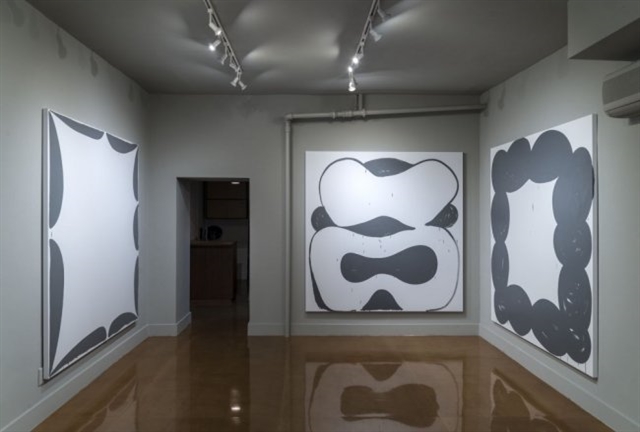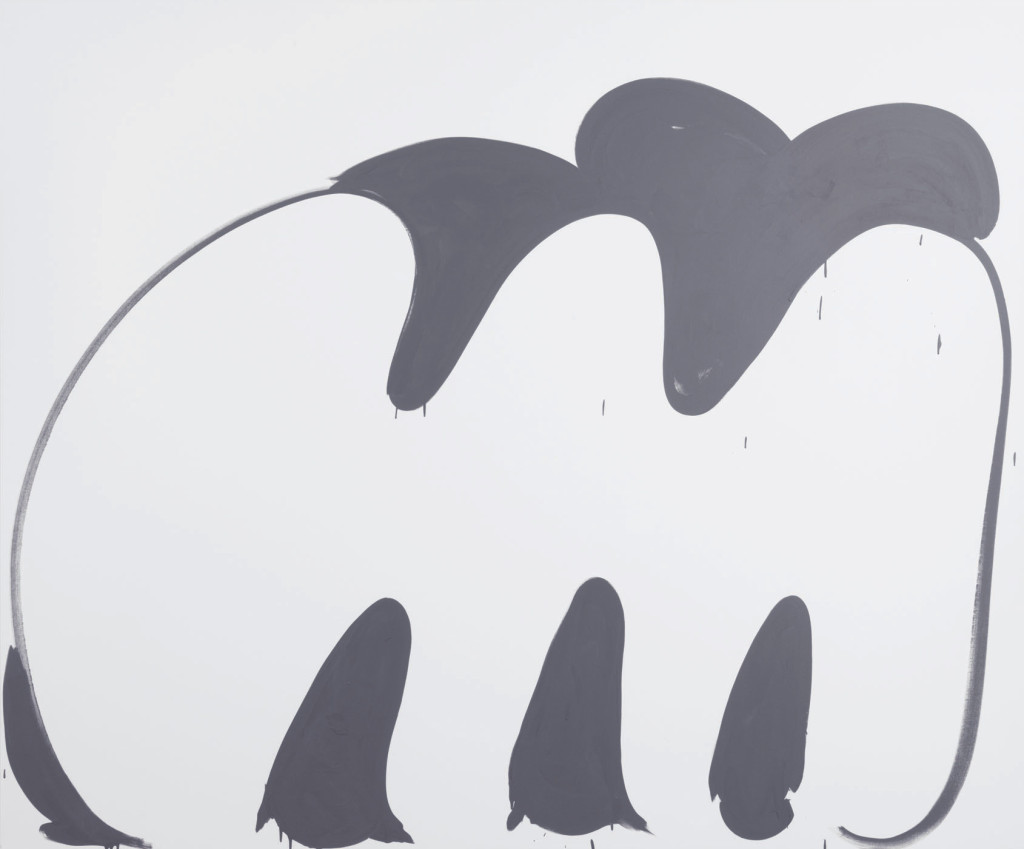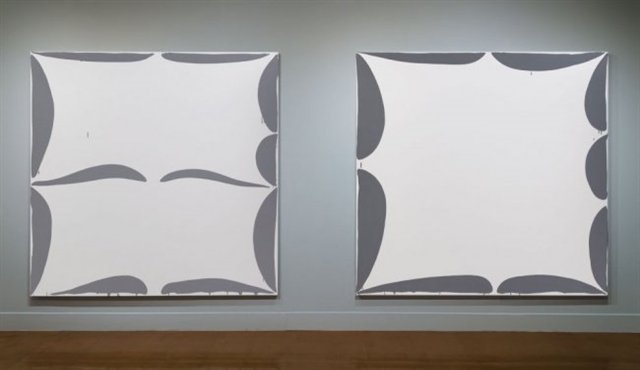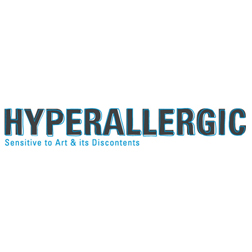
Installation view of Amy Feldman’s ‘High Signs’ (all photographs courtesy of Blackston Gallery)
Among the crop of painting shows that opened this season in New York, Amy Feldman’s High Signs is particularly notable for its visual impact and irreverent sense of humor. The front room of Blackston Gallery offers five large scale paintings in Feldman’s signature gray and white barrage of spontaneously doodled canvases. Daubed quickly in vigorous gray paint, there is a sense of immediacy and of action committed in the heat of the moment. Splashes, drips, and flurries of the brush inundate the otherwise matte gray surfaces. Each painting is enacted in one sitting, often times after lightly sketching her plan of attack and meditating on the surface. This practice might be viewed as a re-enactment of sorts, a conjuring of juvenile, casual energies. Each of these paintings beings with a series of sketches in sharpie marker on notebook paper. The translation from sketchy daydream to fully realized painting seems somewhat like a performance in its own right. This is a reimagining; the result is like looking through a foggy car window at a familiar landscape. While we experience a common sense of graphic power, her compositions carry differences born in the moment of their creation. The resulting images hover in front of the eye as they conflate positive and negative space.

Amy Feldman, “Spirit Merit” (2014) acrylic on canvas
Feldman’s “Open Omen” is a playfully chunky starburst of white unpainted canvas defined by joyful borderlands of dark gray paint. These oblong islands seem to peer inward at one another; an all knowing diaspora of charismatic smears pushed to the edges of the painting. “Psyche Alike,” hung several feet away, features a similar host of mischievous spheres scuttling their way around the perimeter. The resulting space has a powerful presence halfway between a smirking star and a drunken mandala. Together this pair gives an elusive sense of ornament and simplicity from across the room. It is only in approaching the two that their latent complexity comes to bear through each brushstroke and drip of paint. Wrought in two different shades of gray, sustained looking seems to make the paintings shift back and forth against the gray painted gallery walls. I blink twice, unsure if my eyes are playing tricks on me, but the paint differs in color just perceptibly enough to register.

Left to right: Amy Feldman, “Psych Alike” (2014) acrylic on canvas and “Open Omen” (2014) acrylic on canvas
Her “Gut Smut” is defined by a muscular cloud ring of charcoal paint. Its surface seems to ripple and giggle with evidence of hazily sketched paint. Again, the action starts on the borders of the painting, but the eye is pulled to the surface along skeins of brushwork and into the center. The image seems to shift from one moment to the next, it’s final state unresolved, like a maze that is constantly reconstructing itself. I can’t but help feel this painting is teasing me with a pixie-like glee, enticing me to glance across the surface. This sense of instability is taken to cartoonish, smile inducing heights in “Spirit Merit” the abstracted form seems to slouch forward with a well meaning stare. This is an abstract sketch writ large and possessed by the spirit of Snoopy. I look at it and I’m perplexed, then I smile and I can’t stop.
In a smaller room in the back of the gallery, against gray walls painted slightly darker, two series of four 20-square-inch square paintings, Popular Mantra and Hour Triumphs are a study in repetition and chance. All eight paintings are obvious riffs on the monumental painting “Killer Instinct,” though one can’t help but feel that rather than pay homage or copy, the artist has gone back to her original marker sketch. They behave like siblings; though they share a similar genetic structure, they are ultimately shaped in different ways, yielding eight strikingly different paintings, each with its own unique personality and energy. At first the similarities are striking, but the incident of painting lead the artist to undertake a range of choices. This seems like a winking demonstration aimed at proving how important the moment of painting actually is. In fact the entire show seems to reinforce the importance of the hand. All the planning, theory, and carefully crafted art speak go out the window the moment paint hits canvas. These paintings were born in that space where luck, sensitivity, and effort commingle. They feel lucky and are undoubtedly the product of risk taking: a happy reminder that sometimes it pays off.
Amy Feldman’s High Signs continues at Blackston Gallery (290 Ludlow Street, Lower East Side, Manhattan) through October 26.
